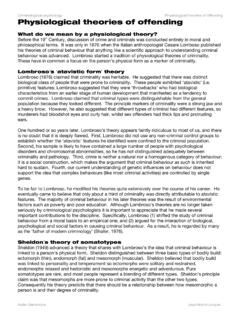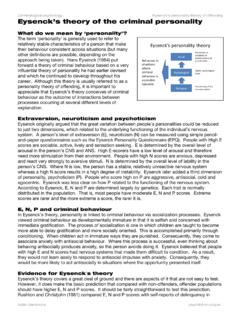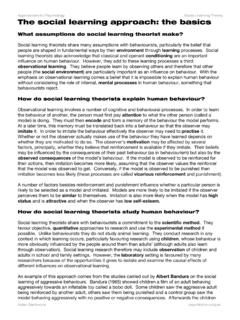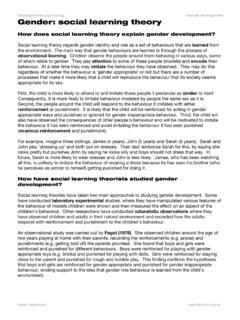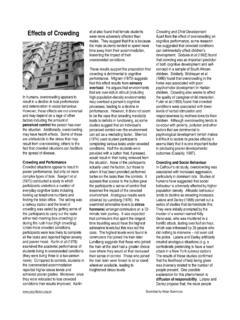Transcription of Criminological psychology Biological theories of offending ...
1 Criminological psychology Biological theories of offending Aidan Sammons Biological theories of offending Is there a gene for crime? There is no gene for crime. Modern behavioural genetics has advanced far beyond the simplistic single defective gene ideas associated with Lombroso and others. Any serious attempt to link criminal behaviour with genetic inheritance will start from the view that the nervous system is the organ that determines our behaviour. Each of as has a nervous system whose structure and functioning determines how we learn from and respond to our environment.
2 Since the organisation of our nervous system is dependent to some extent on our genetic inheritance it follows that our behaviour, including criminal behaviour, may be influenced by our genes. This view is a long way from the Lombrosian one and embodies very different ideas about how genes may affect behaviour. First, there is an assumption that any particular behaviour is affected by many different genes ( is polygenetically influenced). Second, it is assumed that genes must interact with the environment.
3 They represent a potential to develop in particular ways but different behavioural potentials will only be fulfilled with the operation of a suitable environmental trigger. Third, there is no assumption that crime is caused by a defective genetic inheritance; rather, the genetic influences which may lead to crime are regarded as part of the normal genetic variability within our species. So genes do not cause crime. Under particular environmental influences they may give rise to certain ways of behaving that are criminal under some circumstances.
4 Hollin (1992) identifies two important questions in relation to this area: (1) is there evidence for a genetic influence on crime; and (2) if so, how does it operate? The first question may be addressed by using the usual tools of genetic research in psychology : family history, twin and adoption studies. Family history studies Criminal behaviour has a tendency to run in families. Osborne and West (1982) compared the sons of criminal and non-criminal fathers. They found that 13 per cent of the sons of the non criminal fathers had criminal convictions, compared with 40 per cent of the sons of criminal fathers.
5 This is a reliable finding. Clearly, this is consistent with a genetic influence on offending but it can hardly be regarded as conclusive evidence for the same. It is equally consistent with the idea that criminal behaviour is learned within the family or that a third variable, such as poverty, accounts for criminal behaviour in both fathers and sons (Hollin, 1989). Even if we accept that the higher rate of criminality in the sons of criminal fathers is attributable to genetics, it is still necessary to explain why 60 per cent of them did not go on to commit crimes and why 13 per cent of the sons of non-criminal fathers did (Ainsworth, 2000).
6 Twin studies Twin studies, in which the similarity of mono- and dizygotic twins in respect to particular traits is compared, go some way to addressing the weaknesses of family history studies. Early twin studies generally found higher concordance for criminality amongst MZ than DZ twins, which would support the suggestion of a genetic influence. However, much of the early research was flawed by a combination of small samples and poor methods for determining zygocity ( whether a particular twin pair was MZ or DZ).
7 Better, more recent studies have addressed these issues and it is noteworthy that they have generally produced lower estimates for the heritability of criminal tendencies than the early research (Putwain & Sammons, 2002). The most convincing studies come from Denmark, where researchers have access to extensive data on over 3,500 twin pairs. Christiansen (1977) found MZ concordance rates of 35 per cent, compared with 13 per cent for DZ twins. Dalgard and Kringlen (1976), in Norway, found similar results: MZ 26 per cent, DZ 15 per cent.
8 Criminological psychology Biological theories of offending Aidan Sammons As with the family history data, these results are consistent with a genetic influence on criminal behaviour. However, several points should be stressed. First, though the MZ concordances are higher than the DZ they are not especially high, suggesting that any genetic influence on criminality is likely to be slight. Second, since MZ twins are usually treated more similarly than DZ twins, and because DZ twins may be a boy and a girl, the increased concordances for MZ twins may still be attributable to environmental influences.
9 Adoption studies In an adoption study, the similarities between adopted children and their Biological and adoptive offspring are compared. Where the similarity is greatest with the adoptive parents an environmental influence can be assumed on the characteristic in question. Conversely, where there is greater similarity with the Biological parents this may indicate a genetic influence. Several such studies suggest a genetic influence on criminality. Crowe (1972) found that where the Biological mother had a criminal record, the child ran a 50 per cent risk of acquiring one by the age of 18, compared with only a 5 per cent risk where the Biological mother did not have a criminal conviction.
10 Hutchings and Mednick (1975) found that where neither Biological nor adoptive father had a criminal record, the son went on to get one about 10 per cent of the time. This rose to 11 per cent where only the adoptive father had a criminal record, 21 per cent where only the Biological father had one and 36 per cent where both had a criminal record. More recently, Mednick et al (1994) found no relationship between the number of criminal convictions of adoptive parents and their adopted children but a significant correlation between the number of criminal convictions of the Biological parents and their offspring (although only for property crimes, not violent crimes).
